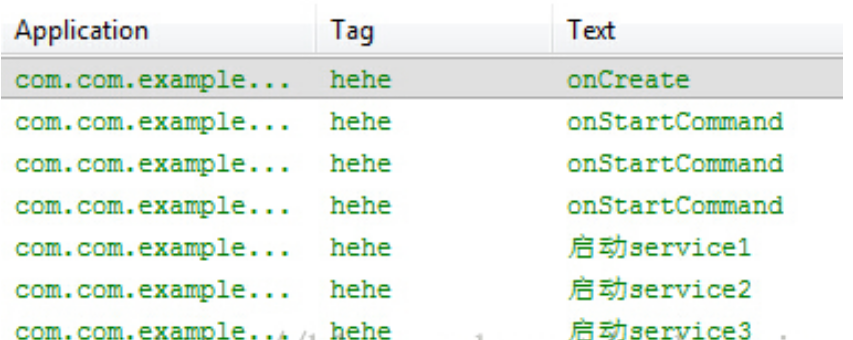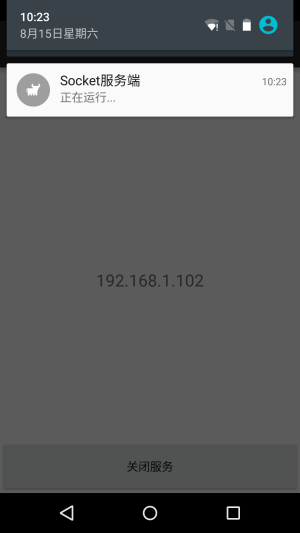上节我们学习了 Service 的生命周期,以及两种启动 Service 的两种方法,本节继续来深入了解 Service 中的 IntentService,Service 的使用实例:前台服务与轮询的实现!
1.IntentService 的使用
在上一节后我们已经知道了如何去定义和启动 Service,但是如果我们直接把耗时线程放到 Service 中的 onStart()方法中,虽然可以这样做,但是很容易会引起 ANR 异常(Application Not Responding),而 Android 的官方在介绍 Service 有下面这样一段话:
直接翻译:
1.Service 不是一个单独的进程,它和它的应用程序在同一个进程中
2.Service 不是一个线程,这样就意味着我们应该避免在 Service 中进行耗时操作
于是乎,Android 给我们提供了解决上述问题的替代品,就是下面要讲的 IntentService;IntentService 是继承与 Service 并处理异步请求的一个类,在 IntentService 中有一个工作线程来处理耗时操作,请求的 Intent 记录会加入队列。
工作流程:
客户端通过 startService(Intent)来启动 IntentService;我们并不需要手动地区控制 IntentService,当任务执行完后,IntentService 会自动停止;可以启动 IntentService 多次,每个耗时操作会以工作队列的方式在 IntentService 的 onHandleIntent 回调方法中执行,并且每次只会执行一个工作线程,执行完一,再到二这样!
再接着是代码演示,网上大部分的代码都是比较 Service 与 IntentService 的,定义足够长的休眠时间,演示 Service 的 ANR 异常,然后引出 IntentService 有多好!这里就不演示 Service 了,网上的都是自定义 Service,然后在 onStart()方法中 Thread.sleep(20000)然后引发 ANR 异常,有兴趣的可以自己写代码试试,这里的话只演示下 IntentService 的用法!
TestService3.java
public class TestService3 extends IntentService { private final String TAG = "hehe"; //必须实现父类的构造方法 public TestService3() { super("TestService3"); } //必须重写的核心方法 @Override protected void onHandleIntent(Intent intent) { //Intent是从Activity发过来的,携带识别参数,根据参数不同执行不同的任务 String action = intent.getExtras().getString("param"); if(action.equals("s1"))Log.i(TAG,"启动service1"); else if(action.equals("s2"))Log.i(TAG,"启动service2"); else if(action.equals("s3"))Log.i(TAG,"启动service3"); //让服务休眠2秒 try{ Thread.sleep(2000); }catch(InterruptedException e){e.printStackTrace();} } //重写其他方法,用于查看方法的调用顺序 @Override public IBinder onBind(Intent intent) { Log.i(TAG,"onBind"); return super.onBind(intent); } @Override public void onCreate() { Log.i(TAG,"onCreate"); super.onCreate(); } @Override public int onStartCommand(Intent intent, int flags, int startId) { Log.i(TAG,"onStartCommand"); return super.onStartCommand(intent, flags, startId); } @Override public void setIntentRedelivery(boolean enabled) { super.setIntentRedelivery(enabled); Log.i(TAG,"setIntentRedelivery"); } @Override public void onDestroy() { Log.i(TAG,"onDestroy"); super.onDestroy(); } }
复制代码
AndroidManifest.xml 注册下 Service
<service android:name=".TestService3" android:exported="false"> <intent-filter > <action android:name="com.test.intentservice"/> </intent-filter> </service>
复制代码
在 MainActivity 启动三次服务:
public class MainActivity extends Activity { @Override protected void onCreate(Bundle savedInstanceState) { super.onCreate(savedInstanceState); setContentView(R.layout.activity_main); Intent it1 = new Intent("com.test.intentservice"); Bundle b1 = new Bundle(); b1.putString("param", "s1"); it1.putExtras(b1); Intent it2 = new Intent("com.test.intentservice"); Bundle b2 = new Bundle(); b2.putString("param", "s2"); it2.putExtras(b2); Intent it3 = new Intent("com.test.intentservice"); Bundle b3 = new Bundle(); b3.putString("param", "s3"); it3.putExtras(b3); //接着启动多次IntentService,每次启动,都会新建一个工作线程 //但始终只有一个IntentService实例 startService(it1); startService(it2); startService(it3); } }
复制代码
运行截图:
小结:
当一个后台的任务,需要分成几个子任务,然后按先后顺序执行,子任务 (简单的说就是异步操作),此时如果我们还是定义一个普通Service然后 在onStart方法中开辟线程,然后又要去控制线程,这样显得非常的繁琐; 此时应该自定义一个IntentService然后再onHandleIntent()方法中完成相关任务!
复制代码
2.Activity 与 Service 通信
我们前面的操作都是通过 Activity 启动和停止 Service,假如我们启动的是一个下载的后台 Service,而我们想知道 Service 中下载任务的进度!那么这肯定是需要 Service 与 Activity 进行通信的,而他们之间交流的媒介就是 Service 中的 onBind()方法!返回一个我们自定义的 Binder 对象!
基本流程如下:
1.自定义 Service 中,自定义一个 Binder 类,然后将需要暴露的方法都写到该类中!
2.Service 类中,实例化这个自定义 Binder 类,然后重写 onBind()方法,将这个 Binder 对象返回!
3.Activity 类中实例化一个 ServiceConnection 对象,重写 onServiceConnected()方法,然后获取 Binder 对象,然后调用相关方法即可!
3.一个简单前台服务的实现
学到现在,我们都知道 Service 一般都是运行在后来的,但是 Service 的系统优先级还是比较低的,当系统内存不足的时候,就有可能回收正在后台运行的 Service,对于这种情况我们可以使用前台服务,从而让 Service 稍微没那么容易被系统杀死,当然还是有可能被杀死的...所谓的前台服务就是状态栏显示的 Notification!
实现起来也很简单,最近做的项目刚好用到这个前台服务,就把核心的代码抠出来分享下:
在自定义的 Service 类中,重写 onCreate(),然后根据自己的需求定制 Notification;定制完毕后,调用 startForeground(1,notification 对象)即可!
核心代码如下:
public void onCreate(){ super.onCreate(); Notification.Builder localBuilder = new Notification.Builder(this); localBuilder.setContentIntent(PendingIntent.getActivity(this, 0, new Intent(this, MainActivity.class), 0)); localBuilder.setAutoCancel(false); localBuilder.setSmallIcon(R.mipmap.ic_cow_icon); localBuilder.setTicker("Foreground Service Start"); localBuilder.setContentTitle("Socket服务端"); localBuilder.setContentText("正在运行..."); startForeground(1, localBuilder.getNotification());}
复制代码
运行效果截图:
4.简单定时后台线程的实现
除了上述的前台服务外,实际开发中 Service 还有一种常见的用法,就是执行定时任务,比如轮询,就是每间隔一段时间就请求一次服务器,确认客户端状态或者进行信息更新等!而 Android 中给我们提供的定时方式有两种使用 Timer 类与 Alarm 机制!
前者不适合于需要长期在后台运行的定时任务,CPU 一旦休眠,Timer 中的定时任务就无法运行;Alarm 则不存在这种情况,他具有唤醒 CPU 的功能,另外,也要区分 CPU 唤醒与屏幕唤醒!
使用流程:
Step 1:获得 Service:AlarmManager manager = (AlarmManager) getSystemService(ALARM_SERVICE);
Step 2:通过 set 方法设置定时任务 int anHour = 2 * 1000;long triggerAtTime = SystemClock.elapsedRealtime() + anHour;manager.set(AlarmManager.RTC_WAKEUP,triggerAtTime,pendingIntent);
Step 3:定义一个 Service 在 onStartCommand 中开辟一条事务线程,用于处理一些定时逻辑
Step 4:定义一个 Broadcast(广播),用于启动 Service 最后别忘了,在 AndroidManifest.xml 中对这 Service 与 Boradcast 进行注册!
参数详解:set(int type,long startTime,PendingIntent pi)
①type:有五个可选值:
AlarmManager.ELAPSED_REALTIME:闹钟在手机睡眠状态下不可用,该状态下闹钟使用相对时间(相对于系统启动开始),状态值为 3;
AlarmManager.ELAPSED_REALTIME_WAKEUP 闹钟在睡眠状态下会唤醒系统并执行提示功能,该状态下闹钟也使用相对时间,状态值为 2;
AlarmManager.RTC 闹钟在睡眠状态下不可用,该状态下闹钟使用绝对时间,即当前系统时间,状态值为 1;
AlarmManager.RTC_WAKEUP 表示闹钟在睡眠状态下会唤醒系统并执行提示功能,该状态下闹钟使用绝对时间,状态值为 0;
AlarmManager.POWER_OFF_WAKEUP 表示闹钟在手机关机状态下也能正常进行提示功能,所以是 5 个状态中用的最多的状态之一,该状态下闹钟也是用绝对时间,状态值为 4;不过本状态好像受 SDK 版本影响,某些版本并不支持;
PS:第一个参数决定第二个参数的类型,如果是 REALTIME 的话就用:SystemClock.elapsedRealtime( )方法可以获得系统开机到现在经历的毫秒数如果是 RTC 的就用:System.currentTimeMillis()可获得从 1970.1.1 0 点到现在做经历的毫秒数。
②startTime: 闹钟的第一次执行时间,以毫秒为单位,可以自定义时间,不过一般使用当前时间。 需要注意的是,本属性与第一个属性(type)密切相关,如果第一个参数对应的闹钟 使用的是相对时间(ELAPSED_REALTIME和ELAPSED_REALTIME_WAKEUP),那么本属 性就得使用相对时间(相对于系统启动时间来说),比如当前时间就表示为: SystemClock.elapsedRealtime();如果第一个参数对应的闹钟使用的是绝对时间 (RTC、RTC_WAKEUP、POWER_OFF_WAKEUP),那么本属性就得使用绝对时间, 比如当前时间就表示为:System.currentTimeMillis()。
③PendingIntent: 绑定了闹钟的执行动作,比如发送一个广播、给出提示等等。PendingIntent 是Intent的封装类。需要注意的是,如果是通过启动服务来实现闹钟提示的话, PendingIntent对象的获取就应该采用Pending.getService (Context c,int i,Intent intent,int j)方法;如果是通过广播来实现闹钟提示的话, PendingIntent对象的获取就应该采用 PendingIntent.getBroadcast (Context c,int i,Intent intent,int j)方法;如果是采用Activity的方式来实现闹钟提示的话,PendingIntent对象的获取 就应该采用 PendingIntent.getActivity(Context c,int i,Intent intent,int j) 方法。如果这三种方法错用了的话,虽然不会报错,但是看不到闹钟提示效果。
复制代码
另外:
从 4.4 版本后(API 19),Alarm 任务的触发时间可能变得不准确,有可能会延时,是系统对于耗电性的优化,如果需要准确无误可以调用 setExtra()方法~
核心代码:
public class LongRunningService extends Service { @Override public IBinder onBind(Intent intent) { return null; }
@Override public int onStartCommand(Intent intent, int flags, int startId) { //这里开辟一条线程,用来执行具体的逻辑操作: new Thread(new Runnable() { @Override public void run() { Log.d("BackService", new Date().toString()); } }).start(); AlarmManager manager = (AlarmManager) getSystemService(ALARM_SERVICE); //这里是定时的,这里设置的是每隔两秒打印一次时间=-=,自己改 int anHour = 2 * 1000; long triggerAtTime = SystemClock.elapsedRealtime() + anHour; Intent i = new Intent(this,AlarmReceiver.class); PendingIntent pi = PendingIntent.getBroadcast(this, 0, i, 0); manager.set(AlarmManager.ELAPSED_REALTIME_WAKEUP, triggerAtTime, pi); return super.onStartCommand(intent, flags, startId); }}
复制代码
AlarmReceiver.java
public class AlarmReceiver extends BroadcastReceiver {
@Override public void onReceive(Context context, Intent intent) { Intent i = new Intent(context,LongRunningService.class); context.startService(i); }}
复制代码















评论